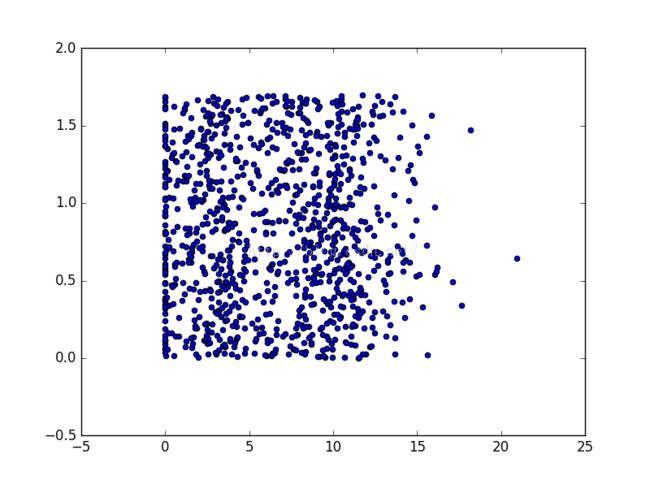机器学习实战之——KNN k-邻近算法
主要内容
l K-邻近分类算法——>使用距离测量的方法对物品分类
l 从文本文件中解析和导入数据
l 使用Matplotlib创建扩散图
l 归一化数值
1. 算法概述
这个算法非常有效,且易于掌握.
通过测量不同特征值之间的距离进行分类.
一个样本训练集,这个训练集中的每个数据都存在一个标签.(已知数据与数据所属分类).
输入新的数据后,新数据的每个特征与样本集中数据的特征进行比较,提取出新数据额标签值(即所属分类).
1.1 准备:Python导入数据
from numpy import * #导入NumPy数据包
import operator #导入运算符模块
from os import listdir
def createDataSet(): #createDataSet函数,创建数据集和标签
group =array([[1.0,1.1],[1.0,1.0],[0,0],[0,0.1]])
labels=['A','A','B','B'] #labels包含每个数据点的标签信息
return group,labels1.2 实施KNN算法
def classify0(inX,dataSet,labels,k):
dataSetSize=dataSet.shape[0];
diffMat = tile(inX,(dataSetSize,1))-dataSet
sqDiffMat=diffMat**2
sqDistances=sqDiffMat.sum(axis=1)
distances=sqDistances**0.5
sortedDistIndicies=distances.argsort()
classCount={}
for i in range(k):#以下对前K个距离最近的样本的标签值进行投票
voteIlabel=labels[sortedDistIndicies[i]]
classCount[voteIlabel]=classCount.get(voteIlabel,0)+1
sortedClassCount=sorted(classCount.iteritems(),
key=operator.itemgetter(1),reverse=True)
return sortedClassCount[0][0]1.3 如何测试分类器
不同算法在不同数据集上的表现可能完全不同。错误率用来评估分类器在某个数据集上的执行效果。
分类器的错误率=错误结果次数/测试执行的总数。
2. 算法在现实世界的应用
2.1准备数据:从文本文件中解析数据
#将文本记录仪转换为NumPy的解析程序
#以此处理输入格式问题;
#输入文本为文件名 字符串
#输出为训练样本矩阵和类标签向量
def file2matrix(filename):
fr=open(filename)
arrayOLines=fr.readlines()
numberOfLines=len(arrayOLines)
returnMat=zeros((numberOfLines,3))
classLabelVector=[]
index=0
for line in arrayOLines:
line=line.strip()#去除字符串首尾指定字符
listFormLine=line.split('\t')#按水平制表符对每行字符串进行切片
returnMat[index,:]=listFormLine[0:3]
classLabelVector.append(int(listFormLine[-1]))#python中可以使用索引值-1表示列表中的最后一列元素
index+=1
return returnMat,classLabelVector2.2分析数据:使用Matplotlib创建散点图
如果只采用矩阵属性列1和2展示数据,产生的图像显示结果如下所示:
2.3准备数据:归一化数值
#归一化特征值
def autoNorm(dataSet):
minVals=dataSet.min(0)
maxVals=dataSet.max(0)
ranges=maxVals-minVals
normDataSet=zeros(shape(dataSet))
m=dataSet.shape[0]
normDataSet=dataSet-tile(minVals,(m,1))
normDataSet=normDataSet/tile(ranges,(m,1))
return normDataSet,ranges,minVals2.4测试算法:作为完整程序验证分类器
通常,我们将已有数据的90%作为训练样本来训练分类器,
10%数据去测试分类器,检测分类器的正确率。
程序中,定义一个计数器变量,每次分类器错误的分类数据,计数器加一。
程序完成后,计数器结果/数据点总数即错误率。
#测试分类器错误率
def datingClassTest():
hoRatio=0.10
datingDataMzt,datingLabels=file2matrix('datingTestSet2.txt')
normMat,ranges,minVals=autoNorm(datingDataMat)
m=normMat.shape[0]
numTestVecs=int(m*hoRatio)
errorCount=0.0
for i in range(numTestVecs):
classifierResult=classify0(normMat[i,:],normMat[numTestVecs:m,:],datingLabels[numTestVecs:m],3)
print "the classifier came back with:%d,the real answer is:%d" %(classifierResult,datingLabels[i])
if(classifierResult !=datingLabels[i]):errorCount+=1.0
print "the total error rate is:%f" %(errorCount/float(numTestVecs))结果输出:
>>>datingClassTest()
theclassifier came back with:3,the real answer is:3
theclassifier came back with:2,the real answer is:2
theclassifier came back with:1,the real answer is:1
the classifiercame back with:1,the real answer is:1
theclassifier came back with:1,the real answer is:1
theclassifier came back with:1,the real answer is:1
theclassifier came back with:3,the real answer is:3
theclassifier came back with:1,the real answer is:1
………………
theclassifier came back with:2,the real answer is:2
theclassifier came back with:1,the real answer is:1
theclassifier came back with:3,the real answer is:1
thetotal error rate is:0.050000
2.5使用算法:创建完整可用系统
#约会网站预测函数
def classifyPerson():
resultList=['not at all','in small doses','in large doses']
percentTats=float(raw_input("percentage of time spent playing video games?"))
ffMiles=float(raw_input("frequent flier miles earned per year?"))
iceCream=float(raw_input("liters of ice creram consumed per year?"))
datingDataMat,datingLabels=file2matrix('datingTestSet2.txt')
normMat,ranges,minVals=autoNorm(datingDataMat)
inArr=array([ffMiles,percentTats,iceCream])
classifierResult=classify0((inArr-minVals)/ranges,normMat,datingLabels,3)
print "you will probably like this person: ",resultList[classifierResult -1]控制台运行结果:
3.示例:手写识别系统
3.1准备数据:将图像转换为分类器可以识别的格式
两个文件:
trainingDigits(约2000个例子)训练分类器
testDigits(约900个例子)测试分类器
为了使用前面的kNN分类器,我们必须把每个图像的32*32矩阵转化为1*1024矩阵。
编写函数img2vector,将图像转化为向量:
① 先创建一个1*1024的NumPy数组
② 打开给定的文件,循环读出文件的前32行,同时将每行的前32个字符存储在NumPy数组中,
③ 返回数组
代码示例:
#示例二:手写识别
#将图像转换为测试向量
def img2vector(filename):
returnVect=zeros((1,1024))
fr=open(filename)
for i in range(32):
lineStr=fr.readline()
for j in range(32):
returnVect[0,32*i+j]=int(lineStr[j])
return returnVect3.2测试算法:使用knn算法识别手写数字
#手写数字识别系统的测试代码
def handwritingClassTest():
hwLabels = []
trainingFileList = listdir('trainingDigits') #load the training set
m = len(trainingFileList)
trainingMat = zeros((m,1024))
for i in range(m):
fileNameStr = trainingFileList[i]
fileStr = fileNameStr.split('.')[0] #take off .txt
classNumStr = int(fileStr.split('_')[0])
hwLabels.append(classNumStr)
trainingMat[i,:] = img2vector('trainingDigits/%s' % fileNameStr)
testFileList = listdir('testDigits') #iterate through the test set
errorCount = 0.0
mTest = len(testFileList)
for i in range(mTest):
fileNameStr = testFileList[i]
fileStr = fileNameStr.split('.')[0] #take off .txt
classNumStr = int(fileStr.split('_')[0])
vectorUnderTest = img2vector('testDigits/%s' % fileNameStr)
classifierResult = classify0(vectorUnderTest, trainingMat, hwLabels, 3)
print "the classifier came back with: %d, the real answer is: %d" % (classifierResult, classNumStr)
if (classifierResult != classNumStr): errorCount += 1.0
print "\nthe total number of errors is: %d" % errorCount
print "\nthe total error rate is: %f" % (errorCount/float(mTest))
测试结果:
…….
…….
但是,这个算法在这里的执行效率并不高,因为需要为每个测试向量做2000次距离计算,每次计算包含1024个维度浮点运算,总计要执行900次。此外,还需要为测试向量准备2MB的存储空间。
K决策树就是K邻近算法的优化版,可以大量节省计算开销。
4、小结
KNN是分类算法中最简单最有效算法。
缺点,空间、时间复杂度都非常大。需保存全部数据集,若训练数据集很大,需使用大量存储空间;必须对数据集中的每个数据计算距离值,实际使用时可能非常耗时。
使用该算法的前提是:必须要有接近实际数据的训练样本数据;足够大的存储空间(需保存全部数据集,若训练数据集很大,需使用大量存储空间)。





